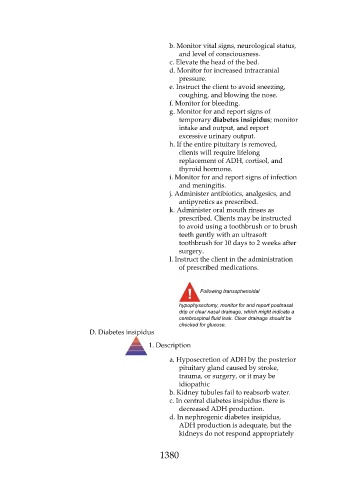Page 1380 - Saunders Comprehensive Review For NCLEX-RN
P. 1380
b. Monitor vital signs, neurological status,
and level of consciousness.
c. Elevate the head of the bed.
d. Monitor for increased intracranial
pressure.
e. Instruct the client to avoid sneezing,
coughing, and blowing the nose.
f. Monitor for bleeding.
g. Monitor for and report signs of
temporary diabetes insipidus; monitor
intake and output, and report
excessive urinary output.
h. If the entire pituitary is removed,
clients will require lifelong
replacement of ADH, cortisol, and
thyroid hormone.
i. Monitor for and report signs of infection
and meningitis.
j. Administer antibiotics, analgesics, and
antipyretics as prescribed.
k. Administer oral mouth rinses as
prescribed. Clients may be instructed
to avoid using a toothbrush or to brush
teeth gently with an ultrasoft
toothbrush for 10 days to 2 weeks after
surgery.
l. Instruct the client in the administration
of prescribed medications.
Following transsphenoidal
hypophysectomy, monitor for and report postnasal
drip or clear nasal drainage, which might indicate a
cerebrospinal fluid leak. Clear drainage should be
checked for glucose.
D. Diabetes insipidus
1. Description
a. Hyposecretion of ADH by the posterior
pituitary gland caused by stroke,
trauma, or surgery, or it may be
idiopathic
b. Kidney tubules fail to reabsorb water.
c. In central diabetes insipidus there is
decreased ADH production.
d. In nephrogenic diabetes insipidus,
ADH production is adequate, but the
kidneys do not respond appropriately
1380

